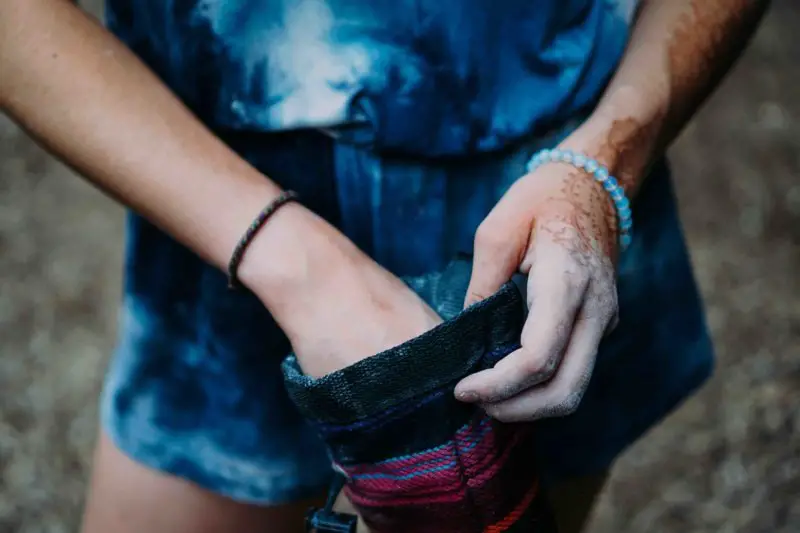Climbing without chalk is like eating soup at a restaurant without a spoon.
But how do you use climbing chalk?
Chalk is probably one of the most important things in any climber’s toolkit. However, it’s quite commonly misused.
Have you ever entered a climbing gym only to be hit by an impenetrable chalk cloud?
That’s chalk overuse at its finest.
Don’t shy away from using it, however, make sure you apply a thin but even chalk coat on both hands before climbing. After that, don’t clap your hands together, but rather gently rub them against each other to make the application more even.
Make sure not to use too much chalk as that won’t necessarily improve your grip, quite the contrary, over-chalking will make it feel like you’re climbing on dust and will most probably cause you to slip as you’ll lose friction.
Why should you use climbing chalk?
Just like gymnasts and weightlifters, climbers use chalk to keep their hands dry and to maintain a strong grip.
Our pores produce moisture in the form of sweat, oils and other secretions, even more so when we’re working out, you could eventually wipe it off, but it won’t be long until you start sweating again, taking you right back where you started from.
Chalk, on the other hand, can absorb the moisture on your hands, leaving them nice and dry so that you can concentrate on your climbing route instead of worrying about slipping.
This might not be a problem for other athletes like sprinters, however, as a climber, having good friction and a secure grip on the handholds can be the difference between success and failure.
Any type of chalk will do the trick, so the choice comes down to personal preference.
Different types of climbing chalk and their respective application methods
We now know why we use it, but what is climbing chalk actually made of and is there a difference between climbing chalk and normal chalk?
Long answer short, yes, there’s a difference between climbing chalk and normal chalk.
Normal chalk, which you can find in classrooms is made of calcium carbonate, which dissolves in water, so you couldn’t use it for athletic purposes, as it would dissolve in your sweat.
Climbing chalk, however, most commonly consists of magnesium carbonate (MgCO3), which doesn’t dissolve in water. It can also have different colors, not to mention that there are even chalk substitutes, which are specifically designed to comply with environmental conservation measures.
How many chalk types are there?
Climbing chalk generally comes in 4 types, block chalk, loose chalk, chalk balls and liquid chalk, let’s go through them one by one.
Block chalk
These blocks usually come in a cardboard or paper packaging and can be ground to make loose chalk they’re usually in packs of 8 (this is my recommended pack of eight 2 ounce blocks of block chalk on Amazon) weighing about a pound in total. However, they can be bought individually.
How to use chalk blocks
You can simply rub your hands against the chalk block and also against each other to get an even coating.
Loose chalk
This is the chalk type that might immediately come to mind when someone’s thinking about chalk. It’s the most dreaded type although it’s quite easy to use. You should avoid it while training in a climbing gym as it can get quite messy and the chalk build-up in the air might ruin the experience for your fellow climbers.
The buildup on the holds can also reduce the friction and lead to more slippery handholds. This is especially true for slopers, which is why you might often see people brushing excess chalk from the handholds before climbing by using a climbing brush like the ones in this set by Escape climbing.
How to use loose chalk
Get a little bit of loose chalk on each hand and rub them together to get all of the excess chalk off. Ideally, you want a little bit of chalk on your hands to keep them dry and for optimal friction, so use it in moderation, as using too much can work against you by causing you to lose your grip, when I’m using loose chalk, I usually go for FrictionLabs’ Chalk, it’s inexpensive and prevents my hands from getting raw from using too much force on a given problem. When I’m sport climbing, however, I tend to go for a chalk ball since I tend to dip my hand in the chalk bag and get too much on, which means that I’d have to blow it off making quite a mess especially when I’m pumped.
Chalk dust can also cause coughing and isn’t ideal for breathing, so try to use as much as you need and no more than that, it can also clog your gyms ventilation systems, which is one of the reasons why most gyms only allow chalk balls or liquid chalk.
It’s inevitable that your chalk bag gets spilled. When that happens, be sure to clean up the loose chalk to avoid everyone accidentally kicking it around or stepping on it and to maintain a clean and healthy training environment for yourself as well as other athletes.
Chalk balls
These are by far the easiest and tidiest to use, as they’re the most preferred for indoor use. Chalk balls are essentially chalk powder in netting or a piece of cloth that allows for it to seep through when you press it. The advantage is that you can take it with you without worrying about creating a mess, the downside is that you won’t be able to get as much chalk on your hands with a chalk ball, as you would with regular, loose chalk.
A lot of chalk balls are one-time use; however, I once tried a refillable one (click here to see it on Amazon) and it was great!
Not only was it affordable, costing less than a pizza! It also came filled to the brim and didn’t have any bad smell like some other more or less expensive variants. It can easily be refilled by opening it and using the cardboard from a toilet paper roll as a funnel and purring in the loose chalk of your choice. After that, you need to tamp in the chalk using a screwdriver handle or anything that has a somewhat larger and flat surface, like a spray bottle to compress the chalk, not the most elegant way, but hey! It gets the job done.
Finally, you seal the chalk ball. Remember to do this at home on a dry surface that you can clean afterward, definitely not on your couch.
How to use chalk balls
Chalk balls are fairly easy to use, you can simply press the chalk ball with your hands or rub your fingers against it to get the desired chalk coating, after which you simply rub your hands together for a better application. You might have to dust your hands off a bit to get the excess chalk off, but this is the least wasteful way to use chalk plus your climbing partners will thank you cause they won’t be breathing in any chalk powder and your climbing gym will look a lot cleaner with less chalk on the floor.
Liquid chalk
Liquid chalk is another messless alternative, that’s easy to put on and which has the added benefit of lasting longer. However, it’s also more expensive than the other options. It’s mostly made out of a combination of magnesium carbonate and alcohol; however, different manufacturers use different chemical compounds for their liquid chalk and they’re usually quite secretive when it comes to their formula. The cheaper variants usually can’t keep up with the more demanding climbing regiments, they tend to be a bit messier and don’t do much in terms of sweat absorption, I personally find FrictionLabs’ liquid chalk to be the best, it dries super quickly and leaves a fine chalk layer, which stays on for longer than most other brands.
How to use liquid chalk
You can apply a bit of liquid chalk on the palms of your hands and rub them together, don’t worry if you don’t see anything at first, but once the alcohol evaporates, it will leave behind a thin albeit even layer of chalk.
Liquid chalk is best used when you’re deep-water soloing, or if you’re attempting longer routes because it can last quite a bit longer than loose chalk. Another way to use it is as a base layer before re-chalking later on.
SIDE NOTE: If you have any cuts or bruises on your hands, you should avoid using liquid chalk as it will burn and sting quite a bit.
How much climbing chalk should you use?
It really depends on the type of chalk you’re using. If you’re using loose or powdered chalk, then as little as a handful can be enough to last you an entire session. Chalk balls, on the other hand, are a bit trickier to use since it’s a bit more difficult to get just the right coating for your hands, which is why you see some climbers use both loose and chalk balls in their bags. As for block chalk, you can simply crush half of the block and put it in your chalk bag, while putting the other half in a small zip-locked plastic bag. When it comes to liquid chalk, you shouldn’t overdo it either, since you can use a little bit of it as a base layer which will last you quite a long time and re-chalk using powdered chalk when need be.
How to carry your climbing chalk
Chalk is mostly carried in a chalk bag, which you can clip around your waist with a chalk belt. The added convenience here is that you can slide the chalk bag around, making it easier to perform certain maneuvers. The clip can also make it easier to remove and re-clip your chalk bag. Alternately; you could clip your bag to your harness with a carabiner. I like this one, as it’s much more discrete and less intrusive than most other variants.

